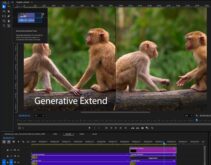The launch of Adobe CS5 brings to bear the obvious comparison with Final Cut Studio (FCS). Since life has been far too quiet lately, I decided to tackle this subject, but from the perspective of the totally new user, not the experienced user who would rather fight than switch. In other words, what would you say if a total newbie asked, “Which should I use, FCS 3 or Adobe CS5?”
Let’s start with price. At Videoguys.com, you can buy CS5 Production Premium for $1,599 and FCS 3 for $949. But your newbie will need an image editor. The most likely candidate is Photoshop CS5, which costs about $700. Add that to $949, and you’re at $1,649, which is close enough to the cost of CS5 to call this one a draw.
Now let’s look at the suite components. For the sake of this one-page column, let’s call the NLEs a draw in terms of functionality and usability. If you’re a beginner, you’ll like Motion (FCS) a whole lot more than the cryptic After Effects (CS5), though After Effects is clearly the professional tool that you should aspire to master. I’ll call Soundbooth (CS5) and Soundtrack Pro (FCS) even, although the noise removal tools in Soundbooth are extraordinary.
With FCS you get Color, a color-grading tool that’s overkill for most beginners and for many intermediate users as well. With CS5 Production Premium you get Illustrator, which is highly functional but not essential for most video producers. Ditto for Flash, though Flash Catalyst, an easier-to-use version of Flash, is a very useful addition.
DVD Studio Pro (FCS) has much deeper DVD authoring functionality (scripting, quizzes, and the like) than Encore (CS5). But it’s harder to learn and doesn’t offer Blu-ray authoring or Encore’s nifty Flash output. Overall, I have Adobe at a slight advantage from a pure product perspective. Now let’s move on to architecture and integration.
Most critical components of CS5 are native 64-bit applications, including Premiere Pro, After Effects, Photoshop, and Adobe Media Encoder. None of the apps in Final Cut Studio are 64-bit. As you know, 64-bit operation means greater access to memory, which generally translates to more efficient and more stable operation. Throw in GPU acceleration via CS5’s new Mercury Engine, and you have a clear advantage, Adobe.
In terms of intersuite integration, Adobe is also superior, starting with editor-to-encoder workflow. In CS5, once you send a project to Adobe Media Encoder, you can immediately return to editing in Premiere Pro. When you “Share” a file in Final Cut Pro, you can also immediately return to editing, but you can’t encode using QMaster, which makes Compressor more efficient on multicore computers. You can still export
to a QuickTime Reference Movie and import that file into Compressor to access QMaster. But depending upon the types of effects that you’ve applied in Final Cut, rendering time can be lengthy, and the intermediate file size could be significant. Neither of these problems exists in CS5.
When producing DVDs, you can export sequences from Premiere Pro to Encore and compositions from After Effects without rendering, which means no rendering until you’re ready to burn the DVD. You can export QuickTime Reference Movies from Final Cut Pro and import them into DVD Studio Pro, with the time and file size issues discussed previously. You also don’t get roundtrip editing with QuickTime Reference Movies; if you need to update your video project
in Final Cut Pro, you have to rerender and reimport. With Encore and Premiere Pro/After Effects, you simply make the change in Premiere Pro/After Effects and save the project, and it flows through to Encore-advantage, Adobe.
What about ProRes? Before CS5, editing H.264-based footage in Premiere Pro, whether AVCHD or from a Canon EOS 7D, was exceptionally painful. I would often ingest the footage into Final Cut Pro and use the resultant ProRes files in Premiere Pro to speed operation. Though Apple’s ProRes continues to be a strength Adobe can’t match, it’s no longer essential for H.264-based footage in CS5 because of 64-bit operation and GPU acceleration and because Adobe is using a vastly more efficient H.264 codec from MainConcept. The advantage goes to Apple because of ProRes, but only by a hair.
If our newbie has Hollywood aspirations, Final Cut Pro has a much larger market share than Adobe Premiere Pro in this community and its feeder schools. Though with portions of record-breaking blockbuster Avatar edited on Premiere Pro, that may be changing. On the other hand, Adobe’s cross-platform support is very helpful for producers with both Mac and Windows workstations in their editing suites.
Looking forward, where CS5 comprises about 50% of revenue for Adobe, FCS is an unknown chunk of 7% of Apple’s “Software, Service and Other” revenue. Logically, you would assume that Adobe will invest more in the success of its editing platform. From what we’ve seen both technologically and from a marketing perspective over the past couple of years, Adobe has. No one can argue that if both platforms stay on the same trajectory they’ve been riding recently, Adobe’s CS platform will emerge as the clear leader, probably sooner rather than later.
So what do I tell my newbie? Overall, Adobe has a slight functional advantage and a clear technology advantage. Adobe has also clearly shown much more commitment to its editing platform over the last couple of versions than Apple. It’s certainly worth noting that CS5 is virtually brand new at this writing and that Apple’s current suite is a year old; also the FCS engineering team is well into the development cycle of an as-yet-unseen new version. Apple’s Steve Jobs has claimed that the next release of Final Cut Pro will be “awesome.” It better be.
 Streaming Learning Center Where Streaming Professionals Learn to Excel
Streaming Learning Center Where Streaming Professionals Learn to Excel








